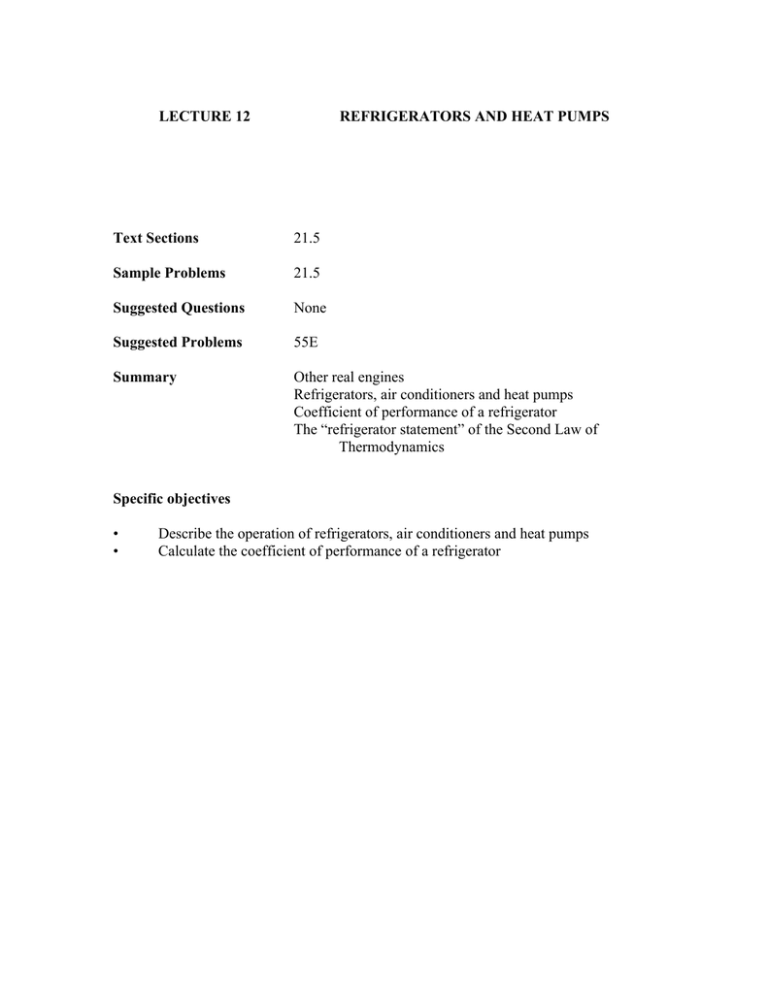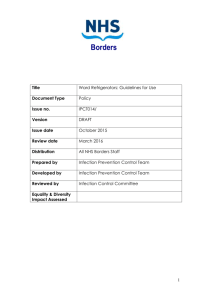LECTURE 12 REFRIGERATORS AND HEAT PUMPS Text Sections Sample Problems
advertisement

LECTURE 12 REFRIGERATORS AND HEAT PUMPS Text Sections 21.5 Sample Problems 21.5 Suggested Questions None Suggested Problems 55E Summary Other real engines Refrigerators, air conditioners and heat pumps Coefficient of performance of a refrigerator The “refrigerator statement” of the Second Law of Thermodynamics Specific objectives • • Describe the operation of refrigerators, air conditioners and heat pumps Calculate the coefficient of performance of a refrigerator LECTURE 12 REFRIGERATORS AND HEAT PUMPS Other real engines Three (at least) other engines are used extensively in everyday life. Each can be approximated by an idealised cycle on a p – V diagram. None of these three engines transfers heat at a constant temperature and hence the ideal efficiency in each case must be calculated from the work output and the heat intake during the cycle. Steam power plants can be approximated by the Rankine cycle. The working substance is steam at high pressure which condenses to water during one process of the cycle. The energy to maintain the high temperature reservoir is usually obtained by burning coal or by nuclear fission processes. Since the plants are typically only about 30% efficient, large amounts of energy (about 70% of the heat transferred from the high temperature reservoir) are transferred as “waste heat” to the cold reservoir, usually a lake, a river or an ocean. It is not energy efficient in a global sense to use electricity directly for heating purposes in homes and workplaces even though it is convenient to do so! The engines in petrol driven cars can be approximated by the Otto cycle. The working substance is a petrol-air mixture, which is replaced after each cycle. The heat intake is provided by chemical reactions (i.e. combustion) in the working fluid and the engine is an example of an internal combustion engine. The efficiency depends only on the compression ratio (the ratio of V1 , the maximum volume of the working substance during the cycle, to V2 , the minimum) and on the ratio of the specific heats of the gas after combustion. The engines in diesel cars, buses and trucks can be approximated by the Diesel cycle. The working substance is a diesel -air mixture, which is replaced after each cycle. These engines are also internal combustion engines since the heat intake is provided by combustion of the fuel mixture. The efficiency depends only on the ratios of the three volumes involved in the cycle and on the ratios of the specific heats of the gas. *** Refrigerators, air conditioners and heat pumps All ideal heat engines can be operated in reverse, i.e. anticlockwise on a p – V diagram, since all processes in their cycle are quasistatic. Most of their real counterparts (e.g. the steam power plants and the petrol and diesel engines described above) can not. Some real Stirling engines can. Some real engines are specifically designed to operate in reverse only, e.g. home refrigerators. In most cases these make use of the fact that real gases (not ideal gases) under certain conditions cool as they expand through a nozzle. This process is called throttling or Joule-Thomson expansion. As mentioned in the last lecture, if an engine operates in reverse, all three energy transfers, QH , W and QC are negative. Heat is transferred from the low temperature reservoir and to the high temperature reservoir and work is done by the environment on the working substance. For this reason, it is customary to redefine these three quantities by reversing their directions so that they are all positive (see Fig 21-12). Heat engines operating in reverse are used as refrigerators, air conditioners and heat pumps. In a household refrigerator heat is transferred from the interior to maintain it at a temperature lower than that of the room. Work (electrical energy) is done in the process. To conserve energy there is a heat transfer (through the rear of the refrigerator) to the room. The First Law gives QH = QC + W . Note that QH , the heat transferred to the room, is always greater than QC , the heat transferred from the interior. It is not possible to cool the room by leaving the door of the refrigerator open! Air conditioners operate in a similar manner. In this case heat is transferred from the room to lower its temperature. Work (electrical energy) is done in the process. To conserve energy there is a heat transfer to the space outside the building. Note that evaporative coolers are not air conditioners. These coolers blow air across water to induce increased evaporation. The net energy extracted from the room is the difference between the energy required to evaporate the water (taken from the room) and the small amount of (electrical) energy required to blow the air across the water. In humid climates evaporative coolers are not effective since there is very little evaporation and hence very little cooling. Heat pumps (sometimes called reverse cycle air conditioners) also operate in a similar manner. Heat is transferred from the space outside the building which is at a lower temperature than the room to be heated. Work (electrical energy) is done in the process. The heat transferred to the room is the sum of these two energy transfers as in the equation above. *** Coefficient of performance of a refrigerator The coefficient of performance of a refrigerator K is defined as K = QC QC = W QH − QC . We saw that for a Carnot engine and for an ideal Stirling engine that QC T = C QH TH . The equation remains the same if we reverse the signs of both QH and Q C . Thus for the corresponding refrigerators K = TC TH − TC . Ideally we would like to extract the maximum amount of heat, i.e. to obtain the maximum amount of cooling, for a given amount of electrical energy used to run the refrigerator. We would like K to be as large as possible. For the Carnot and ideal Stirling refrigerators, K depends on TH - TC ; K is largest when the temperature difference is smallest. This is also true for real refrigerators. For real refrigerators K is typically about 5 when averaged over typical temperature differences. For real room air conditioners the averaged K is typically about 2.5 to 3. The performance of a heat pump is measured in a slightly different way. We are interested in how much heat is transferred to the room for a given amount of electrical energy. KHP = QH W . For real heat pumps, the averaged KHP is typically about 2.5 to 3 . This means that the heat transferred to the room is 2.5 to 3 times the amount of electrical energy used. Heat pumps are much more energy efficient than bar radiators! In a global sense they compensate for the energy losses in power stations. *** The “refrigerator statement” of the Second Law of Thermodynamics Consider the entropy changes in the four systems involved after one cycle of an ideal refrigerator (e.g. Carnot or Stirling) operating between a low temperature and a high temperature reservoir as in Fig 21-12. During the cycle the entropy of the high temperature reservoir increases by QH / TH since the heat transfer occurs at a constant temperature TH . The working substance returns to its initial equilibrium state at the end of the cycle so its entropy returns to the same value. The energy transfer from the environment used to run the refrigerator does not change the entropy of the environment. During the cycle the entropy of the low temperature reservoir decreases by QC / TC since the heat transfer occurs at a constant temperature TC . As we saw in the last two lectures one statement of the Second Law of Thermodynamics is: The total entropy of all systems taking part in a process never decreases. It remains the same only if the process is quasistatic. The increase in the total entropy of the four systems involved is QH / TH - QC / TC . This is zero because all processes in the cycle are quasistatic. Note that it is not possible to set W equal to zero since QH / TH must be at least as large as QC / T C to satisfy the Second Law. To make this true QH must be greater than QC . This leads to another statement of Second Law, the “refrigerator statement” or the Clausius statement: It is impossible for an engine operating in a closed cycle to produce no other effect than to transfer heat continuously from one system to another at a higher temperature. (There are no perfect refrigerators like the one shown in Fig 21-13.) There is an interesting corollary of the Clausius statement known as the Carnot Theorem which sets an upper bound on the efficiencies of real and ideal engines. Any engine operating in a quasistatic cycle extracting heat at temperature TH and discharging heat at a lower temperature TC has the same efficiency as a Carnot engine operating between the same two temperatures; no non-quasistatic engine operating between these temperatures can have a greater efficiency than this. This theorem can be proved by considering the situation in Fig 21-27. The work done by the engine is used to drive a Carnot engine in reverse. If the engine were more efficient than the Carnot engine then the combination would be a perfect refrigerator since QH − QH′ = QC − QC′ = Q > 0 . The engine can be as efficient as a Carnot engine, i.e Q is allowed to be zero. The various statements of the Second Law can all be proved to be equivalent.






